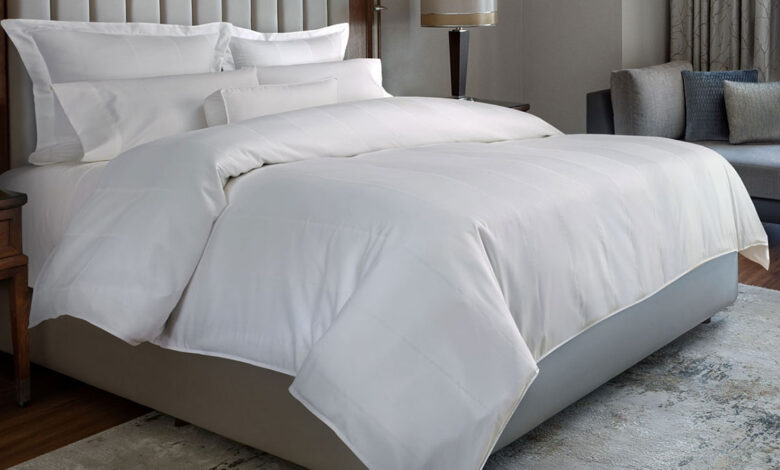Hotel Bedding: The Key to Comfort and Luxury in Hospitality

Hotel bedding plays a critical role in defining the guest experience in any hotel, whether it’s a budget inn or a luxury resort. The bed is often the centerpiece of the room, and the quality of bedding can make or break a guest’s stay. Comfort, durability, and aesthetic appeal are essential factors that hotels must consider when selecting bedding to ensure guests leave with positive impressions and look forward to returning.
This article explores the critical aspects of hotel bedding, including materials, comfort levels, design considerations, and the importance of maintaining high-quality bedding.
The Importance of High-Quality Hotel Bedding
The bed is often the first place a guest experiences upon entering a hotel room. Crisp, clean, and inviting linens are not only expected but have become a standard for many travelers. Hotel bedding needs to be both comfortable and durable, able to withstand frequent washing and use while maintaining its quality over time.
Studies have shown that the quality of sleep guests get during their stay directly impacts their satisfaction. A comfortable bed with luxurious bedding makes a world of difference. It contributes to the overall perception of the hotel’s quality, influencing reviews, repeat bookings, and recommendations.
Material Matters: Fabrics and Fillings
The material used for hotel bedding is perhaps the most significant factor influencing comfort. Hotels must balance comfort with durability when selecting fabrics and fillings, as well as consider ease of cleaning and maintenance.
Cotton: Cotton remains the most popular choice for hotel bedding due to its softness, breathability, and durability. Egyptian and Supima cotton are considered premium options, often used in luxury hotels. These types of cotton have longer fibers, making the sheets feel softer and more durable over time.
Cotton-Polyester Blends: For many mid-range hotels, a blend of cotton and polyester offers a more affordable and practical alternative. Cotton-polyester blends are easier to care for, less prone to wrinkles, and dry quickly, making them ideal for high turnover.
Linen: Linen bedding is typically found in luxury or boutique hotels. It’s highly breathable, moisture-wicking, and has a unique texture that adds a sense of understated elegance to the room. Linen is incredibly durable and softens with every wash, although it can be more expensive and prone to wrinkling.
Down and Down Alternatives: For comforters and pillows, down is highly valued for its lightweight warmth and plush feel. However, due to allergies and ethical concerns, many hotels opt for down alternatives made from synthetic fibers that mimic the softness and insulation of real down.
Thread Count and Weave: How They Impact Comfort
Thread count refers to the number of threads per square inch of fabric and is often used as an indicator of quality. However, a higher thread count does not always equate to better bedding. The weave and quality of the fibers matter more than the sheer number of threads.
Percale Weave: Percale is a plain weave that results in a crisp and cool finish, making it ideal for warmer climates or guests who prefer a fresher feel. Hotels in tropical or warm regions often use percale sheets for their breathability.
Sateen Weave: Sateen, with its silky, smooth finish, offers a more luxurious feel. It has a subtle sheen and is typically heavier and warmer than percale. Hotels in colder climates or those aiming for a high-end, plush feel often opt for sateen.
Thread Count: While thread count in the range of 200 to 400 is often considered optimal for a balance of softness and durability, some luxury hotels may use bedding with a thread count of 600 or more to achieve a more indulgent experience.
Design Considerations for Hotel Bedding
Beyond material and thread count, the aesthetic design of bedding plays a crucial role in creating a cohesive and inviting room atmosphere. Hotel bedding is usually designed to be minimal and classic, often using a white or neutral color palette. This timeless look suggests cleanliness, freshness, and a sense of luxury.
White Bedding: White is a universal choice for hotel bedding. It exudes cleanliness, brightness, and simplicity. The color white also helps to hide wear and tear over time and can be easily bleached during laundering. Most importantly, it fits any room design, ensuring versatility for various hotel styles.
Layering: Many hotels use layers of bedding to create a more inviting and plush look. A typical hotel bed will include fitted sheets, a top sheet, a duvet or comforter, and a decorative throw or blanket at the foot of the bed. Layering not only enhances the visual appeal but also gives guests options for adjusting their comfort.
Pillows: Hotels typically provide multiple pillows in varying firmness levels to cater to different guest preferences. Decorative shams, bolster pillows, and throws can further elevate the bedding’s aesthetic while contributing to a sense of luxury.
Bedding Maintenance: Ensuring Durability and Hygiene
Frequent washing is a significant challenge for hotel bedding, which must maintain its softness, color, and durability after many uses. Bedding is subject to heavy wear, and the importance of maintenance and care cannot be overstated.
High-Quality Detergents: Hotels typically use high-quality detergents that are both effective at removing stains and gentle enough to maintain fabric integrity. Linen care professionals also focus on using the right temperature and chemicals during laundering to prevent fabric breakdown.
Rotation: To extend the life of Direct textile store, most hotels rotate linens, ensuring that the same set is not used repeatedly. This reduces wear and tear on individual items and ensures that fresh, crisp bedding is always available for guests.
Regular Inspections: Regular inspection for signs of wear, such as thinning, discoloration, or fraying, is crucial. Bedding that no longer meets the hotel’s standards must be replaced promptly to maintain quality and guest satisfaction.
The Guest Experience and Hotel Branding
Bedding is more than just a practical necessity; it’s a way to elevate the guest experience and reinforce a hotel’s brand identity. Luxurious bedding can create a memorable experience, helping hotels stand out in a competitive market. Many high-end hotels even offer their bedding for purchase, allowing guests to take a piece of their stay home with them.
From luxury resorts to budget-friendly hotels, bedding is a central element in the overall guest experience. By investing in high-quality materials, offering a range of comfort options, and maintaining rigorous cleaning and replacement standards, hotels can ensure their bedding provides both comfort and style, leaving guests with a lasting impression of relaxation and luxury.
In conclusion, hotel bedding plays a significant role in the success of any hospitality business. Thoughtfully chosen materials, regular upkeep, and attention to guest preferences contribute to a restful, luxurious experience that guests will remember long after their stay.




